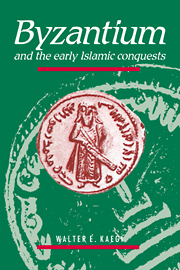Book contents
- Front Matter
- CONTENTS
- List of illustrations
- Preface
- List of abbreviations
- Chapter 1 The problem of Byzantium and the early Islamic conquests
- Chapter 2 The Byzantine Empire in an era of accelerating change
- Chapter 3 Difficulties in devising defenses for Syria
- Chapter 4 The first Muslim penetrations of Byzantine territory
- Chapter 5 Early tests in southern Palestine
- Chapter 6 Problems of cohesion: the battle of Jābiya- Yarmūk reconsidered
- Chapter 7 The brief struggle to save northern Syria and Byzantine Mesopotamia
- Chapter 8 Byzantium, Armenia, Armenians, and early Islamic conquests
- Chapter 9 Controversy and confidence in the seventh-century crisis
- Appendix 1 Author and date of the anti-jewish treatise
- Chapter 10 Elements of failure and endurance
- Bibliography
- Index
Chapter 10 - Elements of failure and endurance
Published online by Cambridge University Press: 22 September 2009
- Front Matter
- CONTENTS
- List of illustrations
- Preface
- List of abbreviations
- Chapter 1 The problem of Byzantium and the early Islamic conquests
- Chapter 2 The Byzantine Empire in an era of accelerating change
- Chapter 3 Difficulties in devising defenses for Syria
- Chapter 4 The first Muslim penetrations of Byzantine territory
- Chapter 5 Early tests in southern Palestine
- Chapter 6 Problems of cohesion: the battle of Jābiya- Yarmūk reconsidered
- Chapter 7 The brief struggle to save northern Syria and Byzantine Mesopotamia
- Chapter 8 Byzantium, Armenia, Armenians, and early Islamic conquests
- Chapter 9 Controversy and confidence in the seventh-century crisis
- Appendix 1 Author and date of the anti-jewish treatise
- Chapter 10 Elements of failure and endurance
- Bibliography
- Index
Summary
STRATEGIC FAILURE
The sixth-century Byzantine diplomat Peter the Patrician prophetically anticipated seventh-century events when, in 562, he warned another eastern power who threatened the Byzantine Empire, namely, the Persian Empire: “We have our fill of war before war has its fill of us … As long as men are evidently winning over their adversary, their courage is cultivated. But when it is obviously failing to destroy their enemies, they waste their own strength and as a result they lose to those who should not conquer them.”
Heraclius had eighteen years in which to find the proper strategy and tactics for crushing the Persians. But he did not have the leisure of eighteen more years to devise or improvise the proper tactics and defenses and counterstrategy against the Muslims. The initial Muslim invasions surprised the military defenders and civilian inhabitants of Syria and Palestine, who were not anticipating any major military activity from the direction of the Arabian peninsula, even though in retrospect modern observers may find warning signs. It is impossible to prove whether Heraclius could have devised an effective strategy against the Muslims if he had possessed more time. He unsuccessfully tried to develop what one may term one variant of a strategy of positional warfare, that of a defense in depth. Such a strategy depends on the control of fixed fortified points and sieges, and a principal object is the control of territory and population in that territory. That strategy did not succeed.
- Type
- Chapter
- Information
- Byzantium and the Early Islamic Conquests , pp. 236 - 287Publisher: Cambridge University PressPrint publication year: 1992

